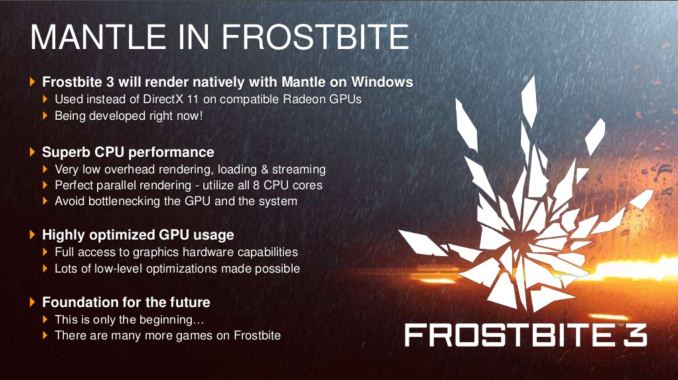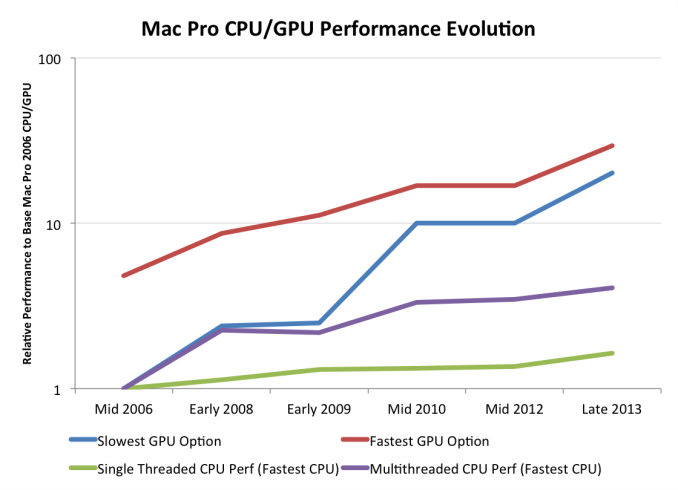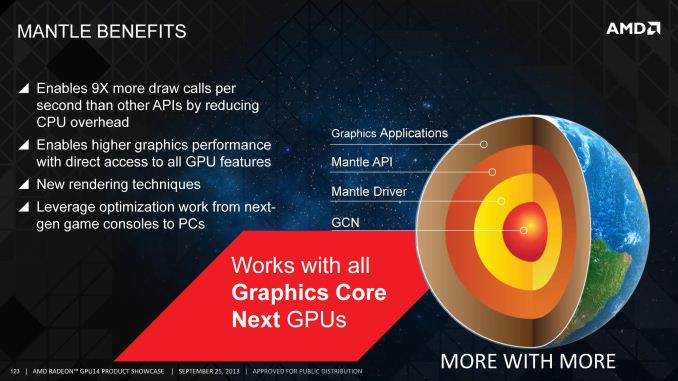Microsoft Announces DirectX 12: Low Level Graphics Programming Comes To DirectX
by Ryan Smith on March 24, 2014 8:00 AM EST
With GDC 2014 having drawn to a close, we have finally seen what is easily the most exciting piece of news for PC gamers. As previously teased by Microsoft, Microsoft took to the stage last week to announce the next iteration of DirectX: DirectX 12. And as hinted at by the session description, Microsoft’s session was all about bringing low level graphics programming to Direct3D.
As is often the case for these early announcements Microsoft has been careful on releasing too many technical details at once. But from their presentation and the smaller press releases put together by their GPU partners, we’ve been given our first glimpse at Microsoft’s plans for low level programming in Direct3D.
Preface: Why Low Level Programming?
The subject of low level graphics programming has become a very hot topic very quickly in the PC graphics industry. In the last 6 months we’ve gone from low level programming being a backburner subject, to being a major public initiative for AMD, to now being a major initiative for the PC gaming industry as a whole through Direct3D 12. The sudden surge in interest and development isn’t a mistake – this is a subject that has been brewing for years – but it’s within the last couple of years that all of the pieces have finally come together.
But why are we seeing so much interest in low level graphics programming on the PC? The short answer is performance, and more specifically what can be gained from returning to it.
Something worth pointing out right away is that low level programming is not new or even all that uncommon. Most high performance console games are written in such a manner, thanks to the fact that consoles are fixed platforms and therefore easily allow this style of programming to be used. By working with hardware at such a low level programmers are able to tease out a great deal of performance of this hardware, which is why console games look and perform as well as they do given the consoles’ underpowered specifications relative to the PC hardware from which they’re derived.
However with PCs the same cannot be said. PCs, being a flexible platform, have long worked off of high level APIs such as Direct3D and OpenGL. Through the powerful abstraction provided by these high level APIs, PCs have been able to support a wide variety of hardware and over a much longer span of time. With low level PC graphics programming having essentially died with DOS and vendor specific APIs, PCs have traded some performance for the convenience and flexibility that abstraction offers.
The nature of that performance tradeoff has shifted over the years though, requiring that it be reevaluated. As we’ve covered in great detail in our look at AMD’s Mantle, these tradeoffs were established at a time when CPUs and GPUs were growing in performance by leaps and bounds year after year. But in the last decade or so that has changed – CPUs are no longer rapidly increasing in performance, especially in the case of single-threaded performance. CPU clockspeeds have reached a point where higher clockspeeds are increasingly power-expensive, and the “low hanging fruit” for improving CPU IPC has long been exhausted. Meanwhile GPUs have roughly continued their incredible pace of growth, owing to the embarrassingly parallel nature of graphics rendering.
The result is that when looking at single threaded CPU performance, GPUs have greatly outstripped CPU performance growth. This in and of itself isn’t necessarily a problem, but it does present a problem when coupled with the high level APIs used for PC graphics. The bulk of the work these APIs do in preparing data for GPUs is single threaded by its very nature, causing the slowdown in CPU performance increases to create a bottleneck. As a result of this gap and its ever-increasing nature, the potential for bottlenecking has similarly increased; the price of abstraction is the CPU performance required to provide it.
Low level programming in contrast is more resistant against this type of bottlenecking. There is still the need for a “master” thread and hence the possibility of bottlenecking on that master, but low level programming styles have no need for a CPU-intensive API and runtime to prepare data for GPUs. This makes it much easier to farm out work to multiple CPU cores, protecting against this bottlenecking. To use consoles as an example once again, this is why they are capable of so much with such a (relatively) weak CPU, as they’re better able to utilize their multiple CPU cores than a high level programmed PC can.
The end result of this situation is that it has become time to seriously reevaluate the place of low level graphics programming in the PC space. Game developers and GPU vendors alike want better performance. Meanwhile, though it’s a bit cynical, there’s a very real threat posed by the latest crop of consoles, putting PC gaming in a tight spot where it needs to adapt to keep pace with the consoles. PCs still hold a massive lead in single-threaded CPU performance, but given the limits we’ve discussed earlier, too much bottlenecking can lead to the PC being the slower platform despite the significant hardware advantage. A PC platform that can process fewer draw calls than a $400 game console is a poor outcome for the industry as a whole.













105 Comments
View All Comments
jabber - Tuesday, March 25, 2014 - link
You don't see Metro/Modern when you are playing games so whats the issue? Come on folks you've had nearly two years to work out how to press a key to switch between the two. Or are some of you not at tech as you think you are?mikato - Tuesday, March 25, 2014 - link
Uh, what if playing games isn't the only thing you do on the computer, and you don't much like having separate computers for games, and for everything else? Nice troll. Here's one - what key do I press to prevent Metro from being used at all as it reduces productivity of pretty much all of my usage scenarios?*(*the usage scenarios where it doesn't reduce my productivity are basically the same ones I use my mobile phone for, except when it is advantageous to be mobile)
Death666Angel - Tuesday, March 25, 2014 - link
I boot up my Win8 PC to the desktop, easily done. I only see the Modern UI when I search for a program, but it has the same impact to me the Win7 search has. I press the "Windows" key, type what I look for, hit enter and the desktop program starts, not at all different from my Win7 usage. And the few features it does bring are much appreciated (better task manager, better file-copy dialogue etc.).ninjaquick - Monday, March 24, 2014 - link
I would guess that Microsoft will limit the release to Windows 8. They desperately need to increase Windows 8 sales, and there are a few core libs that are not present in Windows 7 that are present on all Win8 (Wp8/WinRT/WinX1) distributions.A5 - Monday, March 24, 2014 - link
Like others said, if MS sticks to their timeline Windows 9 will be out by then.Also, Win7 leaves "mainstream support" in January 2015: http://windows.microsoft.com/en-us/windows/lifecyc... So I doubt they'll get a DX update after that point.
A5 - Monday, March 24, 2014 - link
Accidentally added a period to the link. Here's a working one: http://windows.microsoft.com/en-us/windows/lifecyc...Ryan Smith - Monday, March 24, 2014 - link
I didn't have a chance to throw this into the article, but the "mainstream support" angle is a very important one. Microsoft hasn't officially said yes or no at this point, but if they hold to their own lifecycle policy, then Windows 7 will no longer be receiving feature updates as of next year.jabber - Tuesday, March 25, 2014 - link
Mainstream support is just the phone in support. Updates etc. will carry on till 2020.anandreader106 - Monday, March 24, 2014 - link
If Microsoft limits the release to Win8/Win9, what motivation do developers have to require Direct3D 12 if the majority of gamers are using Windows 7?And if developers don't jump on board in order to continue serving the masses, then what's the benefit to all this?
None. Adoption was so bad for 11.1 and 11.2 that Nvidia didn't even support them with their newest architecture!
DarkXale - Tuesday, March 25, 2014 - link
Require? None. But theres plenty of reasons to have it optional.Its hardly uncommon for games to deliver with support for multiple rendering pipelines. The DX9 & DX10/11 is the two most common separations. Having OGL as a third is also not uncommon.
DX12 could end up as an add-on to the D10/11 pipeline, just as D11 is an add-on to the D10 pipeline.